Representatives from Natura Resources, the Zachry Group, Abilene Christian University, the University of Texas–Austin, Texas A&M University, and the Georgia Institute of Technology with the construction permit at NRC headquarters. (Photo: Natura Resources)
The Nuclear Regulatory Commission issued a construction permit yesterday to Abilene Christian University, giving ACU and its partners the go-ahead to build the Molten Salt Research Reactor (MSRR) facility on its Abilene, Texas, campus. The 1-MWt research reactor is the first molten salt–fueled reactor to get a construction permit from the NRC. After Kairos Power’s Hermes, it is the second non–light water reactor construction permit issued by the NRC.
Workers begin construction at the Hermes site in Oak Ridge, Tenn. (Photo: Kairos Power)
Earlier today, on a site in Oak Ridge, Tenn., that was formerly home to the K-33 Gaseous Diffusion Plant, Kairos Power marked the start of construction on its low-power demonstration reactor. Named Hermes, the 35-MWt test reactor claims status as the first Gen IV reactor to be approved for construction by the Nuclear Regulatory Commission and the first non–light water reactor to be permitted in the United States in more than 50 years.
The Engineering Test Unit at KP Southwest. (Photo: Kairos Power)
In October, staff at Kairos Power’s testing and manufacturing facility in Albuquerque, N. M., began transferring 14 tons of molten fluoride salt coolant into an Engineering Test Unit (ETU)—the largest transfer of FLiBe (a mixture of lithium fluoride and beryllium fluoride) since the Molten Salt Reactor Experiment in 1969.
An illustration of an IMSR plant. (Image: Terrestrial Energy)
Ontario–based Terrestrial Energy announced yesterday that its U.S. branch has been awarded a regulatory assistance grant from the Department of Energy to support the company’s Nuclear Regulatory Commission licensing program for the Integral Molten Salt Reactor (IMSR) plant.
April 27, 2023, 9:30AMUpdated April 27, 2023, 9:30AMNuclear News At table, from left: Navid Samandari, chief executive officer of Seaborg Technologies; Jooho Whang, CEO of KHNP; and Jintaek Jeong, CEO of Samsung Heavy Industries. (Photo: Seaborg Technologies)
Denmark-based Seaborg Technologies, developer of the compact molten salt reactor (CMSR), has teamed with two South Korean firms—shipbuilder Samsung Heavy Industries (SHI) and nuclear plant owner and operator Korea Hydro & Nuclear Power (KHNP)—to form a consortium for the development of floating nuclear plants featuring the CMSR. The consortium agreement was signed in Seoul on April 20.
MCRE could be built inside the ZPPR cell (shown here) at INL’s Materials and Fuels Complex. (Photo: INL)
A tiny 200-kWt reactor the Department of Energy says would be the first critical fast-spectrum circulating fuel reactor and the first fast-spectrum molten salt reactor (MSR) could be built and operated inside the Zero Power Physics Reactor (ZPPR) cell at Idaho National Laboratory’s Materials and Fuels Center (MFC). Details included in the Molten Chloride Reactor Experiment (MCRE) draft environmental assessment (EA)—released on March 16 for two weeks of public comment (later extended to four weeks, through April 14)—covered the potential environmental impacts associated with the development, construction, operation, and decommissioning of MCRE at INL, facilitated by the National Reactor Innovation Center (NRIC).
The ARE building at ORNL. (Photo: ORNL)
Experimentation on the world’s first molten salt reactor to potentially power aircraft was already underway in November 1954, being carried out by the U.S. Air Force. Oak Ridge National Laboratory was the scene for the power-dense, high-temperature reactor experiment known as the Aircraft Reactor Experiment (ARE).
The molten salt test loop at ACU’s NEXT Lab. (Photo: Jeremy Enlow/SteelShutter)
The Nuclear Regulatory Commission has announced that it will review a construction permit submitted by the Nuclear Energy eXperimental Testing (NEXT) Laboratory at Abilene Christian University for the lab’s planned molten salt research reactor (MSRR). The NRC informed Rusty Towell, director of the NEXT Lab and professor in ACU’s Department of Engineering and Physics, about its acceptance of the construction permit review in a November 18 letter. The NEXT Lab had submitted the construction permit application on August 15; it was the first-ever university application for an advanced research reactor. On October 14, they provided the NRC with additional information about instrumentation and controls. (Nuclear News featured an article about the NEXT Lab and the MSRR in the November issue.)
The Integrated Effects Test at TerraPower’s laboratory in Everett, Wash. (Photo: Southern Company/TerraPower)
“The world's largest chloride salt system developed by the nuclear sector” is now ready for operation in TerraPower’s Everett, Wash., laboratories. Southern Company, which is working with TerraPower through its subsidiary Southern Company Services to develop molten chloride reactor technology, announced on October 18 that the Integrated Effects Test (IET) was complete. The multiloop, nonnuclear test infrastructure follows years of separate effects testing using isolated test loops, and it was built to support the operation of the Molten Chloride Reactor Experiment (MCRE) at Idaho National Laboratory that the companies expect will, in turn, support a demonstration-scale Molten Chloride Fast Reactor (MCFR).
A cutaway of the Integral Molten Salt Reactor and balance of plant. (Image: Terrestrial Energy)
Ammonia is a carbon-free energy carrier that could be produced using thermal energy from nuclear power plants. Terrestrial Energy announced June 9 that it has signed an agreement with engineering firm KBR to explore the use of its Integral Molten Salt Reactor (IMSR) for both hydrogen and ammonia production.
Rendering of the Thor and Sif concept cruise ships. (Image: Ulstein)
The Norwegian shipbuilding company Ulstein has developed a design concept for a cruise ship fueled by a molten salt nuclear reactor. In the company’s concept, the 500-foot-long, 60-passenger ship, named Thor—in reference to the Norse god as well as the thorium used in the reactor core–would generate its electricity with the onboard reactor. The ship would also serve as a charging station for a fully electric companion ship named Sif, named after the goddess who was Thor’s wife.
Rory O’Sullivan, Moltex Energy’s chief executive officer, North America, speaks at the SNC-Lavalin/Moltex partnership announcement ceremony at CNA2022.
SNC-Lavalin and Moltex Energy are partnering to advance the development and deployment of small modular reactor technology in Canada, the companies announced last week at the Canadian Nuclear Association’s 2022 conference in Ottawa, Ontario. The partnership will support Moltex as it pursues the licensing and construction of its 300-MW Stable Salt Reactor–Wasteburner (SSR-W), a molten salt reactor that uses nuclear waste as fuel.
China’s molten salt loop experiment. (Photo: Thorium Energy World)
China is moving ahead with the development of an experimental reactor that would be the first of its kind in the world and “could prove key to the pursuit of clean and safe nuclear power,” according to an article in New Atlas.
May 21, 2021, 2:41PMNuclear NewsCharles Forsberg and Eric Ingersoll TerraPower and GE Hitachi Nuclear Energy jointly developed the sodium-cooled Natrium reactor with the turbine hall, nitrate heat storage tanks, and cooling towers separated from the reactor at the back of the site.
The viability of nuclear power ultimately depends on economics. Safety is a requirement, but it does not determine whether a reactor will be deployed. The most economical reactor maximizes revenue while minimizing costs. The lowest-cost reactor is not necessarily the most economical reactor. Different markets impose different requirements on reactors. If the capital cost of Reactor A is 50 percent more than Reactor B but has characteristics that double the revenue, the most economical reactor is Reactor A.
The most important factor is an efficient supply chain, including on-site construction practices. This is the basis for the low capital cost of light water reactors from China and South Korea. The design of the reactor can significantly affect capital cost through its impact on the supply chain. The question is, how can advanced reactors boost revenue and reduce costs?

















